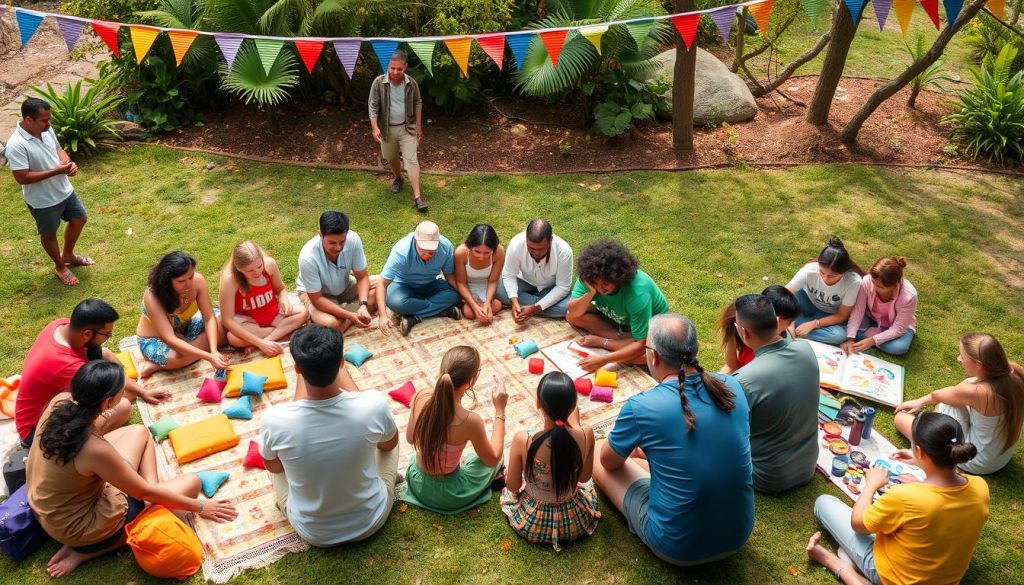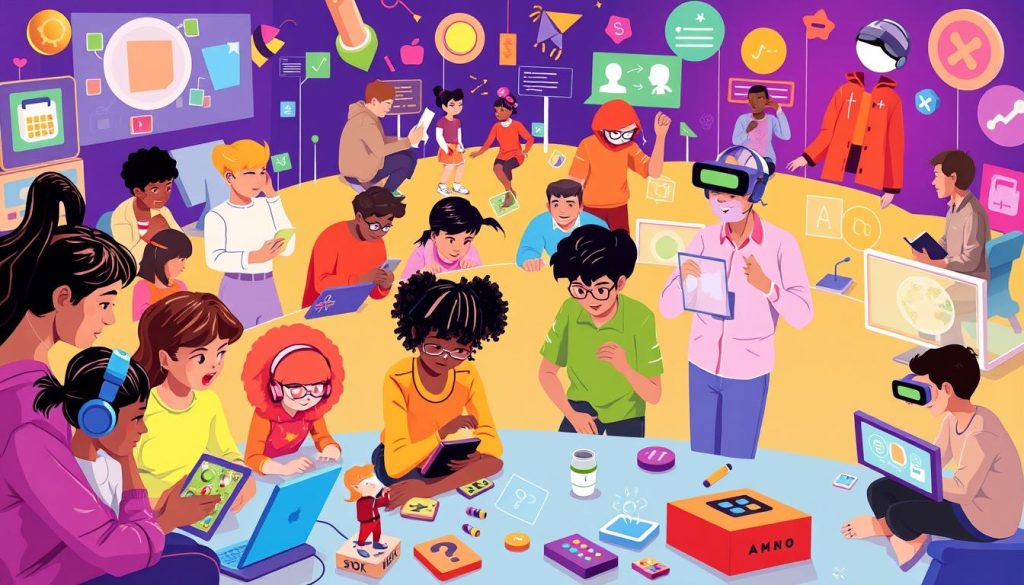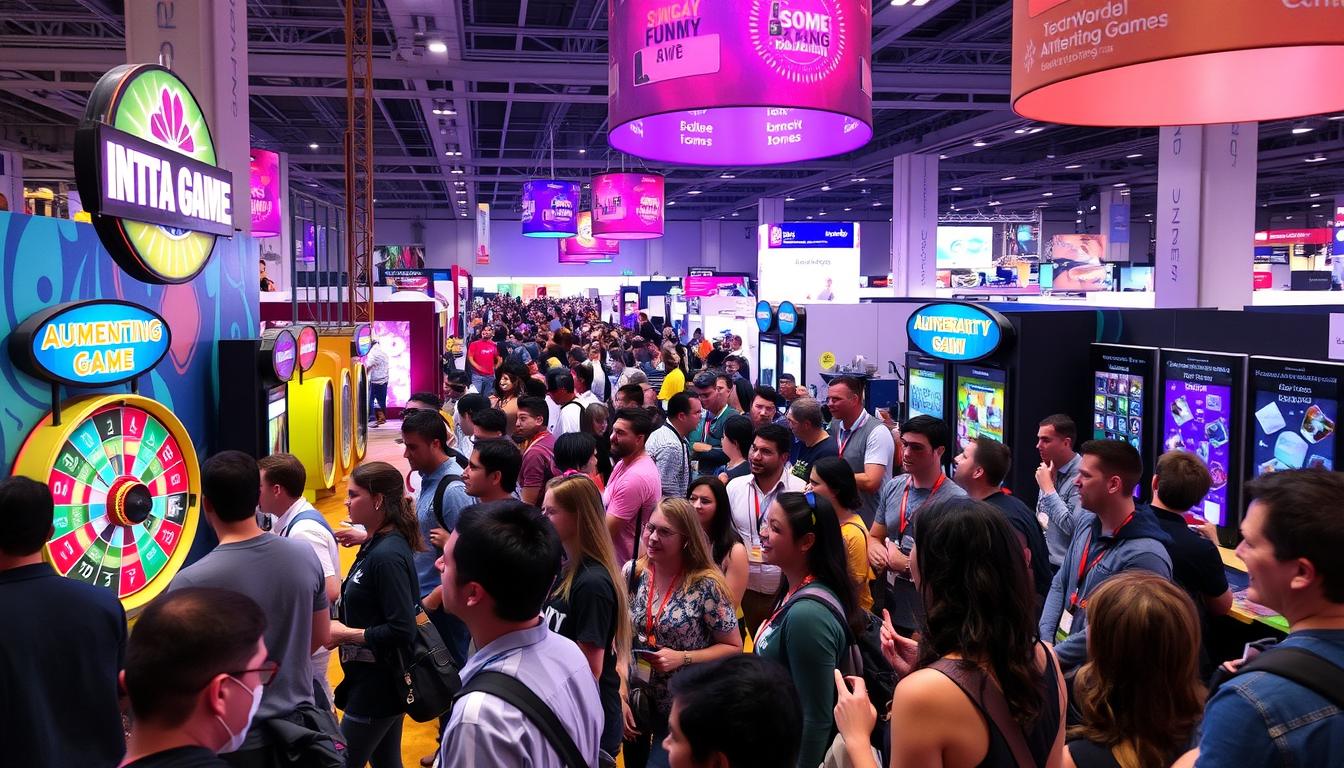Expos and trade shows offer a unique chance to connect with industry peers and potential clients. But how can you make your booth stand out? The answer lies in gamification and interactive learning. By blending education with entertainment, you can create unforgettable experiences that keep attendees engaged and coming back for more.
Interactive games at expos do more than just draw crowds. They provide a fun way to share information about your products or services. This approach helps visitors retain key details while enjoying themselves. It’s a win-win situation that boosts both learning and brand recall.
Gamification in expo settings isn’t just a trend; it’s a powerful tool for meaningful engagement. By tapping into the natural human desire for play and competition, you can create an environment where learning happens naturally. This strategy works across various industries, making it a versatile choice for any expo exhibitor.
Key Takeaways
- Games blend education and entertainment for memorable expo experiences
- Interactive learning enhances information retention and brand recall
- Gamification taps into natural human desires for play and competition
- Interactive elements work across various industries and expo types
- Well-designed games can significantly boost booth engagement and traffic
The Power of Gamification in Event Engagement
Gamification transforms ordinary events into immersive experiences, captivating attendees and boosting engagement. By tapping into the psychology of play, event organizers create interactive learning environments that stick in people’s minds.
Understanding the Psychology of Play
Play activates our brain’s reward system, releasing dopamine and creating positive associations. This makes gamified experiences more memorable and enjoyable. Effective engagement strategies leverage this psychology to keep attendees invested and excited throughout the event.
Benefits of Interactive Learning
Interactive learning boosts information retention and encourages active participation. Attendees who engage with content through games or hands-on activities are more likely to remember key points and apply new knowledge. This approach turns passive listeners into active learners, enhancing the overall event experience.
Creating Memorable Experiences Through Games
Games offer a unique platform for experiential marketing, allowing brands to showcase products or services in an engaging way. By designing custom games that align with event goals, organizers can create lasting impressions that extend beyond the event itself. These immersive experiences foster connections between attendees and brands, much like how personalized services enhance customer loyalty in other industries.
| Game Element | Engagement Impact | Learning Outcome |
|---|---|---|
| Leaderboards | Boosts competition | Encourages mastery |
| Quests | Drives exploration | Promotes problem-solving |
| Rewards | Increases motivation | Reinforces key concepts |
By integrating these elements, event planners can craft unforgettable experiences that educate and entertain, leaving a lasting impact on attendees.
Designing Effective Interactive Experiences
Creating engaging trade show attractions requires careful planning and execution. The key lies in crafting experiences that blend education and entertainment seamlessly. Let’s explore strategies to design captivating interactive experiences that boost audience participation and leave a lasting impression.
Selecting the Right Game Format
Choosing the perfect game format is crucial for maximizing audience engagement. Consider your target audience, event goals, and available space when selecting. Popular options include:
- Quiz shows
- Virtual reality simulations
- Augmented reality scavenger hunts
- Interactive touch screen games
Balancing Education with Entertainment
Successful edutainment concepts strike a delicate balance between learning and fun. Incorporate industry-specific knowledge into entertaining gameplay to create memorable experiences. For example, a mortgage company could design a home-buying simulation game that teaches financial literacy while engaging players.
Technology Integration Strategies
Leveraging technology enhances interactive experiences and boosts audience participation. Consider these strategies:
| Technology | Application | Benefits |
|---|---|---|
| Mobile apps | Event-specific games and challenges | Increased engagement, data collection |
| RFID wristbands | Gamified check-ins, leaderboards | Seamless interactions, personalized experiences |
| Touchscreen displays | Interactive product demonstrations | Hands-on learning, increased product understanding |
By implementing these strategies, you can create immersive trade show attractions that captivate attendees and drive meaningful interactions. Remember to tailor your approach to your specific industry and audience for maximum impact.
Creating Immersive Learning Environments
Transform your expo booth into a captivating learning space that grabs attention and boosts engagement. By focusing on immersive experiences, you’ll create memorable moments that stick with attendees long after the event ends.
Setting Up Interactive Stations
Design stations that encourage hands-on learning. Touch screens, VR headsets, and physical models let visitors explore your content in depth. This interactive learning approach helps information stick better than passive listening.
Incorporating Multimedia Elements
Use a mix of visuals, audio, and video to appeal to different learning styles. Large displays showing dynamic infographics or short films can draw people in. Audio tours or soundscapes add another layer to the experience, making it more engaging and memorable.
Designing Flow-Through Spaces
Create a logical path through your booth that guides visitors from one concept to the next. This flow helps tell your story and keeps people moving, allowing more attendees to enjoy the experience. Consider using subtle visual cues or themed zones to direct traffic naturally.
| Element | Purpose | Example |
|---|---|---|
| Interactive Stations | Hands-on learning | VR product demos |
| Multimedia | Multi-sensory engagement | Animated infographics |
| Flow-Through Design | Guided exploration | Themed learning zones |
By combining these elements, you’ll create a booth that’s not just informative, but truly immersive. This approach to engagement strategies ensures visitors leave with a deeper understanding and a lasting impression of your brand or message.
Building Social Connections Through Group Activities
Group activities play a key role in fostering connections among expo attendees. These engagement strategies not only break the ice but also create lasting bonds. Let’s explore some effective ways to build social connections at your next event.
Team-Building Exercises
Team-building exercises boost audience participation and create a shared experience. A popular activity is the “Human Knot,” where participants stand in a circle, join hands with others across the circle, and work together to untangle themselves. This exercise promotes problem-solving and communication skills.

Networking Games
Networking games are a fun way to facilitate connections. Try “Business Card Bingo,” where attendees collect business cards to fill a bingo card. This game encourages mingling and sparks conversations, making it easier for people to connect.
Collaborative Challenges
Collaborative challenges are excellent experiential marketing tools. Set up a “Puzzle Race” where teams work together to complete a jigsaw puzzle. This activity fosters teamwork and creates a sense of accomplishment. The shared goal brings people together, forming bonds that last beyond the event.
| Activity | Benefits | Time Required |
|---|---|---|
| Human Knot | Problem-solving, Communication | 15-20 minutes |
| Business Card Bingo | Networking, Conversation starter | 30-45 minutes |
| Puzzle Race | Teamwork, Sense of achievement | 45-60 minutes |
By incorporating these group activities, you’ll create a dynamic environment that fosters connections and leaves a lasting impression on attendees. Remember, the key to successful engagement lies in balancing fun with purposeful interaction.
Developing Custom Games for Different Industries
Custom games tailored to specific industries enhance engagement and learning. By integrating gamification and interactive learning, organizations create unique experiences that resonate with their audience. Let’s explore how different sectors leverage edutainment concepts to drive results.
Healthcare Sector Games
In healthcare, interactive learning tools improve patient education and staff training. Hospitals use gamified apps to teach proper hand hygiene, reducing infection rates. Medical students practice procedures in virtual reality simulations, honing skills before treating real patients.
Technology Industry Solutions
Tech companies embrace gamification to boost employee productivity and customer engagement. Software firms create coding challenges that turn bug-fixing into a competitive sport. Customer service teams use gamified platforms to track and improve call performance, enhancing overall service quality.
Educational Institution Applications
Schools and universities adopt edutainment concepts to make learning fun and effective. Language apps use game-like lessons to teach vocabulary and grammar. Science classes employ virtual labs for safe, hands-on experiments.
| Industry | Game Type | Benefit |
|---|---|---|
| Healthcare | VR Surgery Simulations | Improved Surgical Skills |
| Technology | Coding Challenges | Enhanced Problem-Solving |
| Education | Interactive Quizzes | Increased Knowledge Retention |
By developing custom games, industries harness the power of interactive learning to drive engagement and achieve specific goals. This tailored approach ensures that gamification efforts align with organizational objectives and deliver measurable results.
Ensuring Accessibility and Inclusivity in Game Design
Creating inclusive game experiences at expos is crucial for maximizing audience participation and engagement. By embracing diverse learning styles and cultural backgrounds, we can design interactive learning environments that cater to all attendees.
Accommodating Different Learning Styles
To enhance engagement strategies, consider the various ways people absorb information. Visual learners benefit from infographics and diagrams, while auditory learners prefer spoken instructions. Kinesthetic learners thrive on hands-on activities. Tailoring experiences to different learning styles ensures broader participation and better retention.

Creating Universal Design Solutions
Universal design principles make games accessible to all, regardless of abilities. Use clear, large text for readability. Offer alternative input methods for those with mobility issues. Provide captions for audio content and descriptive text for visual elements. These adaptations improve the overall user experience for everyone.
Language and Cultural Considerations
To truly foster inclusive audience participation, consider language barriers and cultural nuances. Offer multilingual options for game instructions and content. Be mindful of cultural sensitivities in game themes and imagery. This approach ensures that all attendees feel welcome and can fully engage in the interactive learning experience.
| Accessibility Feature | Benefit | Implementation Example |
|---|---|---|
| Multi-sensory Feedback | Supports various learning styles | Visual, audio, and tactile cues in games |
| Adjustable Difficulty Levels | Accommodates different skill levels | Easy, medium, and expert modes |
| Cultural Sensitivity Check | Ensures inclusivity | Review content with diverse focus groups |
“Inclusive game design isn’t just about accessibility—it’s about creating experiences that resonate with everyone, fostering a sense of belonging and shared learning.”
Measuring Success Through Analytics and Feedback
Tracking the impact of experiential marketing at expos is crucial for refining engagement strategies. By analyzing data and gathering feedback, organizers can improve retention techniques and create more effective interactive experiences.
Key performance indicators (KPIs) play a vital role in assessing the success of game-based activities. These metrics help gauge attendee participation and learning outcomes. Leveraging advanced analytics tools can provide insights into attendee behavior and preferences.
Data collection methods for expo engagement include:
- Digital check-ins at interactive stations
- Surveys distributed after each activity
- Social media mentions and hashtag tracking
- Game completion rates and scores
Analyzing this data helps identify which retention techniques resonate most with attendees. It also highlights areas for improvement in future events.
“Feedback is the breakfast of champions. It’s essential for creating memorable expo experiences that truly engage and educate attendees.”
To maximize the value of attendee feedback, consider implementing real-time survey tools. These allow for immediate adjustments to engagement strategies during the event.
| Metric | Description | Impact on Strategy |
|---|---|---|
| Participation Rate | Percentage of attendees engaging in activities | Guides resource allocation for future events |
| Knowledge Retention | Post-activity quiz scores | Informs content difficulty and delivery methods |
| Net Promoter Score | Likelihood of recommending the expo | Indicates overall satisfaction and engagement levels |
By consistently measuring and analyzing these metrics, expo organizers can refine their experiential marketing approaches. This data-driven strategy ensures continuous improvement in attendee engagement and knowledge retention.
Maximizing Learning Retention Through Interactive Methods
Interactive learning is a powerful tool for boosting information retention at expos and events. By engaging attendees through hands-on activities, we tap into the brain’s natural ability to remember experiences. Edutainment concepts blend fun with education, creating memorable moments that stick long after the event ends.
Retention techniques like spaced repetition and active recall can be seamlessly woven into expo games. For example, a quiz game that revisits key points throughout the day helps cement new knowledge. Virtual reality simulations offer immersive experiences that make complex ideas tangible and unforgettable.
To maximize learning retention, it’s crucial to engage multiple senses. Touch screens, audio cues, and even scent marketing can create rich, multi-sensory experiences. These diverse stimuli help form stronger neural connections, making it easier for attendees to recall information later. By thoughtfully incorporating these interactive methods, expos can deliver lasting value to both attendees and exhibitors.
FAQ
What are the benefits of using games to educate and entertain expo attendees?
Games offer numerous benefits for expo attendees, including increased engagement, better information retention, and more memorable experiences. They create an interactive learning environment that can make complex topics more accessible and enjoyable. Additionally, games can foster networking opportunities and encourage active participation, leading to a more successful expo experience for both attendees and exhibitors.
How can I balance education and entertainment in expo games?
Balancing education and entertainment is crucial for effective expo games. Start by clearly defining your learning objectives, then design game mechanics that naturally incorporate these goals. Use engaging storytelling, visually appealing elements, and interactive challenges to make the educational content more entertaining. Regularly test and refine your games to ensure they maintain the right balance between fun and learning.
What types of games work best for different industries?
The best games for each industry depend on the specific content and audience. For the healthcare sector, simulation games or medical trivia can be effective. In the technology industry, hands-on demos or coding challenges might work well. Educational institutions could benefit from quiz-style games or interactive storytelling. The key is to tailor the game format to your industry’s unique characteristics and your attendees’ interests.
How can I incorporate technology into expo games?
Technology can greatly enhance expo games through various means. Consider using touchscreen displays for interactive quizzes, virtual reality for immersive experiences, or augmented reality for product demonstrations. Mobile apps can facilitate scavenger hunts or networking games. QR codes can link to additional content or leaderboards. The key is to choose technology that enhances the game experience without overshadowing the educational content.
What strategies can I use to create inclusive games for all attendees?
To create inclusive games, consider implementing universal design principles. Offer multiple ways to participate, such as visual, auditory, and tactile elements. Provide clear, simple instructions in multiple languages if necessary. Ensure physical accessibility for all stations. Consider diverse learning styles and cultural backgrounds when designing game content. Regular feedback from a diverse group of testers can help refine your games for maximum inclusivity.
How can I measure the success of my expo games?
Measuring game success involves both quantitative and qualitative methods. Track metrics like participation rates, completion times, and scores. Use surveys or feedback forms to gather attendee opinions. Analyze lead generation and follow-up engagement rates. Monitor social media mentions and sentiment. Compare these metrics to your predefined goals and previous expo performances. Consider long-term indicators like improved brand recall or increased sales leads to gauge overall success.
What are some effective ways to maximize learning retention through games?
To maximize learning retention, incorporate spaced repetition techniques into your games, revisiting key concepts throughout the experience. Use multi-sensory approaches to engage different learning styles. Implement immediate feedback mechanisms to reinforce correct information. Create opportunities for attendees to apply learned concepts in practical scenarios. Consider providing take-home materials or follow-up digital content to extend the learning experience beyond the expo.
How can I use games to facilitate networking at expos?
Games can be powerful networking tools at expos. Design team-based challenges that require collaboration among strangers. Create scavenger hunts that encourage attendees to interact with different exhibitors. Use leaderboards or competitive elements to spark conversations. Implement digital networking games through event apps, matching attendees based on interests or goals. Remember to provide structured time for follow-up discussions or contact exchanges after game sessions.


